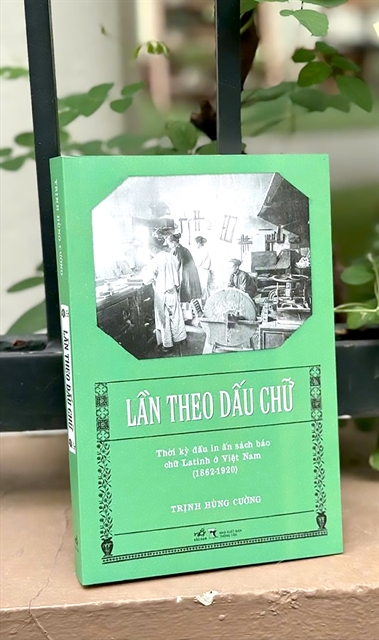 |
| Book collector Trịnh Hùng Cường. |
Trịnh Hùng Cường is a book collector. After many years travelling across the country buying rare books, he has just released his first edition, Lần Theo Dấu Chữ (Tracing the Evolution of Printing Press in Việt Nam), which narrates the history of printing houses from 1862 to 1920.
Việt Nam News reporter Nguyễn Bình chatted with Cường about his book.
How did you come up with the idea about the book? And what motivated you to write it?
I have collected books for many years and during that time I have seen so many book titles which have excited my curiosity. The book titles include Nhà In Quản Hạt (Quản Hạt Printing House), Bản In Nhà Hàng Rey et Curiol (Rey et Curiol Printer's), Nhà In Mê Kong (Mekong Printing House), Nhà In F-H.Schneider (F-H.Schneider Printing House), along with many others.
Printing houses and publishers are tools for producing knowledge and they played an important role for the printing press and publishing in Việt Nam.
I did my research and was surprised that there was no actual book about the Vietnamese printing industry during the colonial period. There are just few articles in both French and Vietnamese and so I decided to write my own book with a view to bring interest to book collectors like myself.
How was the process of writing your first book? How did you solve the difficulties?
Honestly, I'm not a social science researcher, nor do I have writing talents. I have documents and compiled them with my own references and because such documentation is very important, my book is very heavily reliant on the history of the industry.
Over many years I have collected a lot of documents related to the printing industry and I nurtured the book many years ago.
The most difficult thing was getting the documentation to fill in the missing pieces.
I have had to read a lot from year books, gazettes and directories, along with studying advertisements in newspapers in French, with a view to collecting information and piecing them together.
I spend a lot of time cross referencing and checking information about the relationship among characters, printing houses and book houses. Their inheritances, the commercial operations and how they merged, were complex.
Additionally, each printing house has its own chronological table. Not to mention a huge number of pictures and maps that I had to check for each caption and ensure the resolution was high enough.
Plus, I also researched on the internet using sources like the French Gallica digital library and referenced important other resources from other book collectors.
 |
| The book by collector Trịnh Hùng Cường introduces the printing industry in Việt Nam in 1862 - 1920 period. Photo courtesy of Vietnam News Agency Publishing House |
The book introduces printing in the north and the south and printing by the Catholic missions; please tell us more about that?
Printing by the Catholic missions was established very early, in the first days of the French appearing in Việt Nam. During their time the Catholic printers left behind a number of valuable publications such as Dictionary J.S.Theurel and Dictionary J.F.M Génibrel.
These are rare documents which explain the development of the romanized writing system for Vietnamese, and are a suggestion for the compilation of other dictionaries later contributing to further perfecting the national language.
Through publications by the Catholic printers we can review historical periods of the national language development including syllables, words and grammar.
Furthermore, the Catholic printers published books on physics, literature, mathematics and geography. In my opinion, the Catholic printing contributed to the beginning of Việt Nam press. The first Catholic paper, Nam Kỳ Địa Phận (Cochinchina diocese), came into existence in 1908.
So your book is the first complete research about the printing industry in Việt Nam?
According to my understanding, there is a book about Lịch Sử Ngành In Việt Nam (History of Printing in Việt Nam). The first volume was published in 1987 and was a review of printing workers from 1930 related to the national revolution, while the second volume published in 1992 introduces the role of the printing industry in war time, from 1945 to 1975.
The book doesn't mention the formation and development of Latin letter printing, including by the French and the national language at the beginning of the colonial period.
My book offers readers the chance to learn about the entire process of printing Latin letters, development of the printing houses, the important publications, key people in the printing industry and methodical cataloguing of printing houses from 1862 to 1920 period.
Could you tell us more about your old book collection in Việt Nam?
I have had a passion for old books since I was a secondary student. I was at that time living in the northern province of Bắc Ninh so I would travel by bus to Hà Nội and go and buy books at bookstores in Tràng Tiền Street and old bookstores in Lý Thường Kiệt Street.
Collecting old texts and books is very popular in Việt Nam and there are a lot of book exchanges and trading. Some of the book collectors even join the Vietnamese old book auctions abroad.
The interest has also helped to revive bookbinding and book restoration work. Some old bookbinding stores in HCM City and Nha Trang are even expanding in order to serve book collectors.
There are also exhibitions displaying old books and papers which are of great interest. VNS


